David Tickner's Blog, page 37
December 30, 2020
Auld Lang Syne
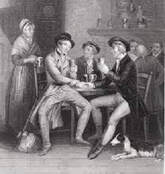 Should auld acquaintance be forgot,
Should auld acquaintance be forgot,and never brought to mind?
Should auld acquaintance be forgot,
and auld lang syne?
Original Scots verse by Robert Burns
Auld Lang Syne is a Scots language poem written in 1788 by Robert Burns (1759 – 1796). The poem is set to the tune of a traditional folk song. In many English-speaking countries, the song is most often sung on New Year’s Eve; however, it is common to hear the song at funerals, graduations, and on other occasions celebrating the close or end of something significant.
The word auld (old) is from 14th century Scottish. The term lang syne (long ago) is Scottish from around 1500. A langsyner was a person who lived long ago. Syne, a Scottish form of the word ‘since’, is from around 1300.
There are several English translations of auld lang syne; for example, old long since, long long ago, days gone by, old times, for the sake of old times, but the most common translation appears to be ‘old times sake’.
In the 17th century (i.e., the time of the Protestant Reformation in Europe), Protestant authorities in the England and Scotland banned Christmas as a ‘popish’ festival; in particular, by Acts of Parliament in 1644 and 1647. In England, this ban remained in effect only until 1660. The 17th century English Puritans in Massachusetts banned Christmas for a generation.
However, in Scotland, Christmas was not officially celebrated for the next three hundred years. During this period, New Year’s became the main mid-winter festival and the singing of Auld Lang Syne became part of these celebrations. Christmas did not become an official holiday in Scotland until 1958.
Reference: Online Etymological Dictionary, https://www.etymonline.com/
https://en.wikipedia.org/wiki/Auld_Lang_Syne
Published on December 30, 2020 10:10
December 24, 2020
Tree
 The word tree has its origins in the Proto-Indo-European (PIE) root deru (to be firm, solid, steadfast; particularly, in relation to wood, tree, and objects made of wood) and PIE drew-o (tree). PIE deru is also the source of the words true and truth.
The word tree has its origins in the Proto-Indo-European (PIE) root deru (to be firm, solid, steadfast; particularly, in relation to wood, tree, and objects made of wood) and PIE drew-o (tree). PIE deru is also the source of the words true and truth.From these PIE beginnings comes Proto-Germanic trewam, the source of Old Frisian tre, Old Saxon trio, Old Norse tre, and Old English treo, treow (tree, particularly the oak tree; also, timber, wood, beam, log, stake) and Old English treowwyrhta (tree-wright; i.e., carpenter).
‘Christmas’ trees have been part of winter festivals since before Christmas. Ancient people recognized and decorated the trees that stayed green during the winter. During the winter solstice Egyptians would celebrate with green palm rushes. During Saturnalia, the Roman celebration of the solstice, homes and temples were decorated with evergreen boughs. The Celts and Vikings celebrated with evergreen boughs, considered symbols of everlasting life.
The contemporary tradition of the Christmas tree is believed to have begun in 16th century Germany when people brought evergreen trees into their homes at Christmas and decorated them with candles. German settlers brought this Christmas tree tradition to the US in the mid-18th century. Other groups in the US at this time resisted the decorating of trees, considering it to be non-Christian. However, by the mid to late 19th century, the decorated Christmas tree gradually took root (so to speak) across the US and Britain, particularly given the influence of Queen Victoria and the annual Christmas tree decorating in her family home.
Reference: Online Etymological Dictionary, https://www.etymonline.com/
Published on December 24, 2020 10:52
December 23, 2020
Holly & Ivy
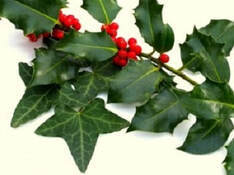 Holly
HollyThe word holly has its origins in Proto-Indo-European (PIE) kel (to prick), Proto-Germanic hulin, and Old English holegn and holen. The 12th century word holin precedes the mid-15th century word holly. Holly is an evergreen shrub long used as part of Christmas decorations.
Ivy
Ivy, a climbing plant, comes from Old English ifig. Before this the origin of the word ivy is unknown. In the mid-15th century the image of an ivy bush was used on the signage of taverns which served wine, ivy being sacred to Bacchus, the Roman god of wine and other things (Bacchus, known as Dionysus in Greek mythology).
Holy & Ivy
In ancient times, holly was thought to be a male plant and ivy a female plant.
The ancient Romans used holly in different ways—to ornament the home as an omen of good fortune and immortality; holly wreaths were sent to newlyweds for the same reason; and holly was used during the December Saturnalia festival. Early Christians, celebrating Christmas at this time, used holly as the spiky leaves symbolized Jesus’s crown of thrones and the red berries symbolized his blood. Harry Potter’s wand is made of holly, by the way.
Ivy, in addition to being associated with wine and intoxication as in the mythology of Bacchus and Dionysus, was also a symbol of fidelity and marriage. Ivy was wound into a crown, wreath, or garland as a symbol of prosperity and charity. As such, ivy was adopted by the early Christian church as a reminder to help the less fortunate.
The Christmas carol ‘The holly and the ivy’ is based upon ancient beliefs which were absorbed by the Christian church. The carol sung today was recorded by Cecil Sharp, a folk song collector, who heard it sung in England in 1909.
Reference: Online Etymological Dictionary, https://www.etymonline.com/
https://davesgarden.com/guides/articles/view/2731
Published on December 23, 2020 10:01
December 22, 2020
Mistletoe
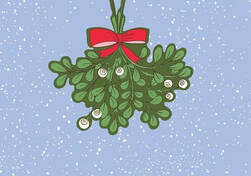 Here’s a bit of a surprise. The word mistletoe may be related to the Proto-Indo-European (PIE) root meigh (to urinate)! The origins of the word mistletoe are unknown; however, one suggestion is that the mistletoe plant is propagated through the droppings of the missel thrush or missel-bird. These droppings are called mih-stu- (urine), a Germanic term from PIE meigh.
Here’s a bit of a surprise. The word mistletoe may be related to the Proto-Indo-European (PIE) root meigh (to urinate)! The origins of the word mistletoe are unknown; however, one suggestion is that the mistletoe plant is propagated through the droppings of the missel thrush or missel-bird. These droppings are called mih-stu- (urine), a Germanic term from PIE meigh.The word mistletoe is first seen in the Proto-Germanic mikhstilaz (mistletoe) which is the source of, among other words, Old Saxon mistil, Dutch mistel, Old High German mistil, and Old English mistel (basil, mistletoe) and mistiltan (mistel twig). Mistletoe is a European plant which grows parasitically on certain trees.
Mistletoe was venerated by the Druids of ancient Britain. The white berries were considered symbols of male fertility (i.e., semen). The ancient Romans hung mistletoe over doorways as a symbol of peace, love, and understanding as well as for protection of the household. Mistletoe was part of the Roman Saturnalia celebrations. Christian Christmas celebrations continued this tradition. The custom of kissing under the Christmas mistletoe appears to have originated in the late 18th or early 19th centuries among the servants of English country houses.
Reference: Online Etymological Dictionary, https://www.etymonline.com/
Published on December 22, 2020 09:49
December 21, 2020
Poinsettia
 The poinsettia gets its name from Joel R. Poinsett (1770 – 1851), the first US Ambassador to Mexico. He brought this plant to the attention of botanists in 1828. He was also a co-founder of what later became known as the Smithsonian Institute.
The poinsettia gets its name from Joel R. Poinsett (1770 – 1851), the first US Ambassador to Mexico. He brought this plant to the attention of botanists in 1828. He was also a co-founder of what later became known as the Smithsonian Institute.Originally, poinsettias were cultivated by the Aztecs for use in traditional medicine. Today, over 70 million poinsettias are sold in the US during the Christmas season in the US and millions more in other countries.
Reference: Online Etymological Dictionary, https://www.etymonline.com/
Published on December 21, 2020 10:34
December 19, 2020
Fallow
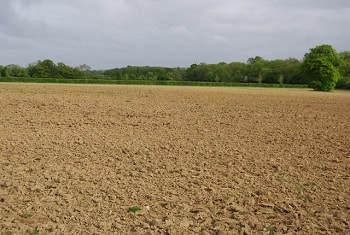 Do you ever feel like taking a day off from everything? Do you ever actually take a day off from everything?!
Do you ever feel like taking a day off from everything? Do you ever actually take a day off from everything?!Or, have you ever used the phrase, ‘just sleep on it’? Leave it for now and come back to it later.
Can we talk about ‘fallow’ time just as we can talk about ‘fallow’ land?
Traditionally, in agriculture, fallow land refers to land which is usually cultivated but which is allowed to lie idle during a growing season in order to restore fertility to the soil.
Fallow has its origins in the Proto-Indo-European (PIE) root pel-(2) (to fold, to turn) and Proto-Germanic falgo, the source of Old High German felga (harrow), German Felge (plowed-up fallow land), Frisian falge (fallow, to break up ground).
The Old English word fealh (fallow land) appears around 1300. By the 1520s, the word fallow (land plowed but not planted) appears in English.
Fallow time. Stop and smell the roses every now and then.
Reference: Online Etymological Dictionary, https://www.etymonline.com/
Published on December 19, 2020 12:46
December 16, 2020
True Stories
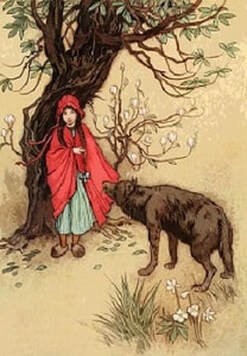 When my daughter was a preschooler, we would read bedtime stories before she got tucked in for the night. One evening, after a fairly typical fairy tale (trolls, wicked stepmothers, enchanted castles, dragons, and so on), my daughter precociously asked, “Daddy, is that story true?” She sounded as if she was somewhere between incredulity and skepticism.
When my daughter was a preschooler, we would read bedtime stories before she got tucked in for the night. One evening, after a fairly typical fairy tale (trolls, wicked stepmothers, enchanted castles, dragons, and so on), my daughter precociously asked, “Daddy, is that story true?” She sounded as if she was somewhere between incredulity and skepticism.In that moment, I have to admit that I was faced with a bit of a dilemma. I could say, perhaps condescendingly, “No, darling daughter, it’s not true. It’s just a story. Now go to sleep.” Or I could say, “Yes, it is true. A good story carries a truth.” At that point, I think that if I had made such a statement my daughter would have said, “Thanks, Dad, but it’s too late for teaching. Turn out the light and let me go to sleep!”
To tell the truth, I can’t remember how I replied to her question. But the question about truth and stories has always been at the back of my mind. The phrase, “It’s just a story”, has always given me pause.
The word true has its origins in the Proto-Indo-European (PIE) root dru (tree) and PIE dreu (to be firm, solid, steadfast).
Let me digress for a moment. Think about trees. They start as seeds and over time can grow to enormous size and strength. Think of the tree outside your window. It probably looks the same in the morning as it does in the afternoon. It may even look the same from one month to the next. But think of trees from one season to another—during the fall they lose their leaves, they rest and renew, and in the spring they burst forth again with leaves and growth. Think about how a tree slowly grows and changes from one year to the next.
What did ancient peoples see or feel about trees that called forth what we now know as the word true? Do the words firm, solid, steadfast in the midst of change indicate what they might have seen in trees and also valued in themselves and in others? Perhaps trees called forth such values from them. In any case, it is clear from historical records that ancient peoples respected and honored the truths which they saw in trees.
Dare I ask if a truth can grow just as a tree can grow? Can a small truth or insight grow into a larger truth just as an acorn grows into a mighty oak? Or, is a truth a truth and it is our knowledge and understanding of it that grows and changes? It seems no surprise that even today the tree is often seen as symbol of knowledge and truth. I realize that I have severely digressed and am speaking metaphorically and not etymologically at this point.
Back to etymology. From PIE dreu comes Proto-Germanic treuwaz (having or characterized by good faith), and Gothic triggws (faithful, trusty; being 'true' to your word). These words come to Old English as trow (to confide, to trust, to believe) and suggest that something is ‘true’ because we ‘trust’ or ‘have faith’ that it is true. The modern German word treu, from these origins, still means faithful.
The phrase ‘true love’ is from Old English treolufu (literally ‘tree love’); that is, love as true as the strength and steadfastness of a tree.
True, meaning consistent with facts or evidence, is first recorded around 1200; true, meaning something real or genuine or not counterfeit is from the late 14th century; true, meaning something conforming to a certain standard is from around 1550.
The phrase ‘to come true’ (e.g., dreams that come true) comes from 1819. The verb ‘to true’ in the sense of to make consistent with a certain standard comes from 1841 (e.g., in carpentry, to make something level or square).
In brief, over the centuries, we see distinctions between truth as ‘fidelity’ or ‘faithfulness’ and truth as ‘factuality’. Does something being 'true' depend on having facts and evidence or having faith? It depends. Are we talking about facts or stories?
Online Etymological Dictionary, https://www.etymonline.com/
Published on December 16, 2020 19:41
December 13, 2020
Helminthologist
When you were a kid, did the adults in your life ever ask you what you wanted to be when you grew up? Have you ever asked the same question of a child? Can you imagine the child saying quite confidently that she or he wanted to be an helminthologist?! Maybe you know a kid who would quite love such an occupation.
The word helminth comes from the PIE root wel-(3) meaning to turn or revolve, and from Greek helmins (parasitic worm). The English word helminth (intestinal worm; particularly in vertebrates) is from 1852.
The science of helminthology began in the 18th century and developed through the 19th century achieving prominence in the first half of the 20th century in the work of the noted Japanese helminthologist, Satyu Yamaguti (1894 – 1976).
And, speaking of turning and revolving: PIE wel-(3) is the source of many other English words such as convolution, devolution, evolution, evolve, involve, revolt, revolve, valve, vault, volume, Volvo, vulva, walk, waltz, and others.
Reference: Online Etymological Dictionary, https://www.etymonline.com/
The word helminth comes from the PIE root wel-(3) meaning to turn or revolve, and from Greek helmins (parasitic worm). The English word helminth (intestinal worm; particularly in vertebrates) is from 1852.
The science of helminthology began in the 18th century and developed through the 19th century achieving prominence in the first half of the 20th century in the work of the noted Japanese helminthologist, Satyu Yamaguti (1894 – 1976).
And, speaking of turning and revolving: PIE wel-(3) is the source of many other English words such as convolution, devolution, evolution, evolve, involve, revolt, revolve, valve, vault, volume, Volvo, vulva, walk, waltz, and others.
Reference: Online Etymological Dictionary, https://www.etymonline.com/
Published on December 13, 2020 21:31
December 11, 2020
Impeccable
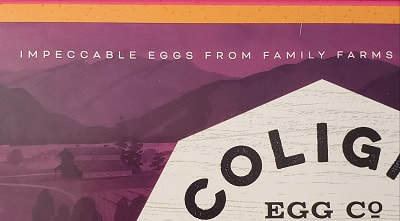 I saw an egg carton in the supermarket on which was written, “Our eggs are impeccable!”
I saw an egg carton in the supermarket on which was written, “Our eggs are impeccable!”“Ha! Ha!” I thought, “Good one.” And then, “Where does the word impeccable come from?” I was happy to learn that impeccable means incapable of sin. The eggs must be really good ones.
One suggestion for the origin of the word impeccable is the Proto-Indo-European (PIE) root ped (foot; from which comes pedicure and pedestrian) and PIE ped-ko (to stumble, impair). Another suggestion is that the word comes from the PIE root pet (to fall) and PIE pet-ko (a fall, an error).
In any case, from such PIE origins comes Latin peccare (to sin, to miss, to make a mistake, to transgress, to offend). The Latin prefix in- (not, opposite of) + peccare = Latin impeccabilis (not liable to sin) which in the 15th century came to French as impeccable and, in the 1530s, came unchanged to English as impeccable (not capable of sin). By the 1610s, impeccable also meant faultless.
I’m still thinking of those eggs in the supermarket. They must have been perfect.
A word related to impeccable is peccadillo (a slight sin, a petty crime or fault) which comes from Latin peccare and Latin peccatum (sin, fault, error), words which are the source of Spanish pecadillo and, by the 1590s, the English word peccadillo.
A brief anecdote related to what must be the shortest military report ever: During the 1840s, Britain was expanding its rule over various parts of India which at that time included what is now Pakistan. British authorities were concerned that their armies did not move too fast or too far afield for fear of overextending themselves. For this reason, one of the generals, Sir Charles Napier, was ordered not to occupy the Pakistani province of Sindh. However, Napier, sensing no resistance occupied the province anyway. His report of victory to the authorities was simply “Peccavi”: meaning both “I have Sindh” and “I have sinned”; i.e., “I disobeyed orders.”
By the way, I bought the eggs. They make an excellent omelette.
Reference: Online Etymological Dictionary, https://www.etymonline.com/
Published on December 11, 2020 23:42
Exile
The verb ‘to exile’
comes to English around 1300
from 12th century Old French essillier (exile, banish, expel, drive off),
from Latin exilium / exsilium (banishment, voluntary exile; place of exile)
from Latin exul (banished person, one who is driven out):
from ex (away) + al
from PIE al- (to wander),
(also, the source of Greek alaomai (to wander, stray, roam)
Exile: a banished person wandering.
In Roman law of the ancient world
death or voluntary exile was the punishment for a capital crime.
Sometimes you had
a choice,
sometimes you did not.
Experts suggest other possible etymologies:
Perhaps exile is
from PIE selh (to take)
to Latin sulere (to take)
to Latin ex + sulere (to take out, or
one who is taken out)
You are banished. You have no choice.
Banishment from community and kinship in the ancient world
would feel like death.
Or, perhaps exile is
from PIE or Greek helh
the root of Greek elauno,
the source of Latin exul (one who is driven out)
Go away! Get out of here! You do not think the way we do!
Or again, perhaps exile is
from PIE al-
to Latin amb + ulare (who walks out; a self-exile)
Leave everyone and everything that has been your life
and never go back.
An exile is either driven away or walks away
from community.
An exile is someone who does not fit, an irritant,
a seed or spore carried by the wind
An exile wanders alone
angry, fearful, perhaps resigned to fate
or destiny.
perhaps, if life smiles, in comfortable solitude
punctuated with moments of loneliness.
perhaps seeking a new or a renewed community
or way of life
or way of being.
Reference: Online Etymological Dictionary, https://www.etymonline.com/
comes to English around 1300
from 12th century Old French essillier (exile, banish, expel, drive off),
from Latin exilium / exsilium (banishment, voluntary exile; place of exile)
from Latin exul (banished person, one who is driven out):
from ex (away) + al
from PIE al- (to wander),
(also, the source of Greek alaomai (to wander, stray, roam)
Exile: a banished person wandering.
In Roman law of the ancient world
death or voluntary exile was the punishment for a capital crime.
Sometimes you had
a choice,
sometimes you did not.
Experts suggest other possible etymologies:
Perhaps exile is
from PIE selh (to take)
to Latin sulere (to take)
to Latin ex + sulere (to take out, or
one who is taken out)
You are banished. You have no choice.
Banishment from community and kinship in the ancient world
would feel like death.
Or, perhaps exile is
from PIE or Greek helh
the root of Greek elauno,
the source of Latin exul (one who is driven out)
Go away! Get out of here! You do not think the way we do!
Or again, perhaps exile is
from PIE al-
to Latin amb + ulare (who walks out; a self-exile)
Leave everyone and everything that has been your life
and never go back.
An exile is either driven away or walks away
from community.
An exile is someone who does not fit, an irritant,
a seed or spore carried by the wind
An exile wanders alone
angry, fearful, perhaps resigned to fate
or destiny.
perhaps, if life smiles, in comfortable solitude
punctuated with moments of loneliness.
perhaps seeking a new or a renewed community
or way of life
or way of being.
Reference: Online Etymological Dictionary, https://www.etymonline.com/
Published on December 11, 2020 20:48



